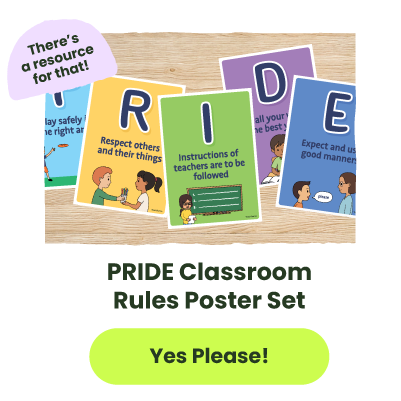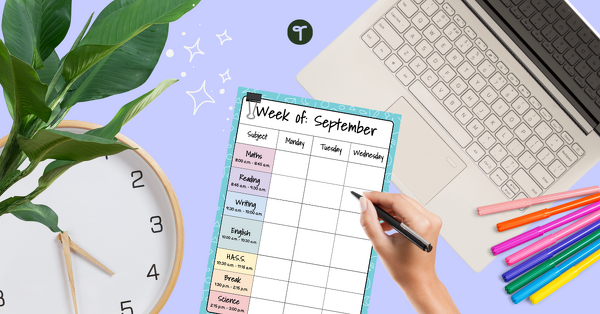When it comes time to set up your very first classroom, it’s tempting to start mounting your classroom rules posters to get ahead of the game. After all, you want to make sure the procedures and expectations are easy for students to spot and follow from the get-go.
Hold on just a second! Save that wall space!
Don’t get us wrong — every community needs rules to thrive, and that includes your classroom community. You will need classroom rules to guide student learning and set expectations.
But in their many years in the classroom, every member of the Teach Starter teaching team has come to the same conclusion: The best classroom rules really are the ones you create with your students. Sure, you know what kind of rules you need in place for the classroom to run smoothly, but guiding students through discussions and questioning to create a solid list of rules enables you to get their buy-in. Suddenly the rules feel like they are your students’ idea, rather than a draconian list of mandates from the teacher.
So how do you write classroom rules with your students? And how do you build a classroom environment where students actually follow the rules?
The teachers on our team have put their heads together to create a guide that will make drafting classroom rules with your class simple and effective.
Why Students Should Write Your Classroom Rules
Writing classroom rules with students may sound a bit like allowing the fox to wander into the henhouse. We promise we aren’t trying to trick you or destroy your behaviour management plans! Working with your students to write classroom rules fosters ownership and supports the collaborative learning process.
When students work together with you to draft a list of rules, they are:
- Seeing that you value their thoughts and opinions. This lays the foundation for a strong teacher-student relationship.
- Flexing their critical thinking muscles. You can use this chance to observe your new students’ problem-solving skills.
- Experiencing collaboration with their classmates. Especially when it’s done early in the school year, this can help foster that sense of community in your classroom.
- Finding their place within the classroom community. Creating their own rules provides students with a chance to feel a connection to those rules and the ways that they work to make the classroom a safe and positive space to learn. This makes it much more likely that they will follow them.

What Are Good Classroom Rules?
Before you — or your students — dive into rule creation, it’s best to set some parameters. This will set everyone up for success. The best classroom rules are:
- Specific. Classroom rules can be creative, but at the end of the day, you don’t want students to have much wiggle room when you’re trying to enforce them. For example, a rule like ‘Do not be mean’ is vague and leaves a lot open to interpretation. Instead a rule like ‘Treat others the way you would like to be treated’ is specific and provides clear guidelines for students. The more specific a rule, the easier it will be for students to follow.
- Consistent. This is something you often hear when it comes to rule enforcement, but it should be true of the rules themselves as well. When rules seem to be contradictory or they don’t work together toward the same end goal, it causes frustration for students and makes it harder for the teacher to enforce.
- Positive (When Possible). Forget what they told you in uni — research shows most teacher training still tells new teachers to come up with strict rules and consequences for misbehaviour. But the veteran teachers will tell you it just doesn’t work!
Rather than a list of instructions that says what students shouldn’t do, make sure your list includes examples of what students should do. For example, instead of ‘No calling out,’ a rule might be written as ‘Wait to be called on before speaking out in class.’
How to Write Classroom Rules With Your Students
Now that you have the why, let’s talk about the how! Writing classroom rules can be a fairly simple process, even when you’re involving small children.
Discuss rules as a class
Let your class know that you would like them to help you write this year’s classroom rules, and open the topic up for discussion.
Some helpful things to keep in mind to give your discussion shape and keep students on track:
- Come prepared with a list of topics you would like your classroom rules to include such as ‘kindness‘ or ‘respect’ OR work as a class to create a list of topics that are important to have rules about in a classroom.
- Brainstorm ways that students could make each of these topics come to life in the classroom. For example, what are some ways to behave kindly to your classmates? What are some behaviours that are unkind to our classmates?
Draft rules in groups
Once you have a strong list of behaviours, break students into small groups. Assign each group one or several behaviours, and challenge them to create a rule or several rules that might address those behaviours.
Finalise the rules
After students have had time to work in their small groups, call the class back together. Ask a representative of each group to present one or all of the rules they have drafted. Write the rules out on your whiteboard.
After the final group has presented, discuss the list of rules on your whiteboard as a class, and narrow it down to a core list of classroom rules together.
A good rule of thumb: Limit your total list of rules to around 5. When you add too many rules, it becomes too much for students.
Once you have your students’ final list of rules, you may notice some important issues have yet to be addressed. This is a good time to bring up those topics, and make sure you get student buy-in on any late additions to your list of classroom expectations and guidelines.
How to Teach Classroom Rules
Once you have your classroom rules set in stone, it’s time to start working with students to help them get acclimated. Get ready — this is going to take some time.
Here’s how the teachers on our team teach classroom rules:
- Go over the rules one by one.
- Practise the rules until you’re tired of hearing them! You’re going to feel like a broken record, but trust us — it’s worth it to keep teaching those rules! The key is to make it fun. Games like behaviour charades, thumbs up/thumbs down expectation sorting and How to Walk Like a … help students get better acquainted with your rules and expectations. Morning meeting time is the perfect chance to review your rules and integrate procedure activities.
- Provide positive reinforcement. When rules are followed, celebrate! Keep track of rule-following with a classroom reward chart and provide rewards that motivate students to stick to the rules.

A Final Word
Writing classroom rules with your class can help prevent behaviour issues, but they’re not a one-and-done matter. Students will need support along the way to be reminded of your expectations and sometimes need to be corrected when they cross over a line.
The more your students feel responsible for their behaviour and understand your classroom expectations, the easier this part of your classroom management strategy will be.
Explore more behaviour management resources and ideas from our expert teacher team!
Banner image via Shutterstock/Kristen Prahl








Comments